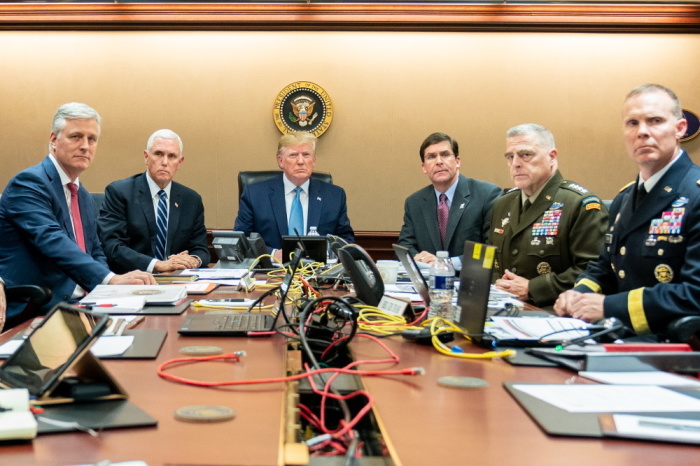Killing Baghdadi does not equal defeating ISIS

On the night of October 26–27, around 50 soldiers of Delta Force entered Idlib, Syria via helicopter, where they cornered Abu Bakr al- Baghdadi, the caliph of the Islamic State (IS), in a tunnel under his compound. Baghdadi detonated the explosive vest he was wearing, killing himself and the three children he had pulled into the tunnel with him. Once the American soldiers had positively identified Baghdadi’s remains, they knew Operation KAYLA MUELLER—named for an American humanitarian worker who died in the group’s custody—had succeeded.
The leader of the deadliest terrorist group in history is dead. Now what?
The Context
Rising from the ashes of al Qaeda in Iraq (AQI), the Islamic State of Iraq and al-Sham (ISIS) burst onto the scene with a lightning campaign through Syria and Iraq in mid-2014, capturing global attention. On June 29, Abu Bakr al-Baghdadi, the group’s leader, spoke at the Great Mosque of al-Nouri in Mosul, declaring the establishment of a caliphate, with himself as caliph. By declaring a caliphate, Baghdadi effectively laid claim to the loyalty of all Muslims worldwide; in theory, all Muslims now owed him their allegiance. Most Muslims rejected Baghdadi’s claim, but a significant number accepted it, with many making hijra (migration) to join the caliph’s state-building project in Iraq and Syria. Baghdadi also renamed the group the Islamic State (IS).
The group’s extreme violence precipitated a strong response from countries throughout the world, including the United States, who led them in forming an anti-IS coalition, the Combined Joint Task Force–Operation INHERENT RESOLVE, in October. In the fall of 2014, IS reached what became its territorial zenith, controlling over 100,000 square kilometers between Iraq and Syria. As the group gained strength, sundry Islamist terrorist organizations and insurgencies from around the world swore baya (allegiance) to Baghdadi, setting up wilayat (provinces/states) in other countries like Afghanistan, Nigeria, the Philippines, and elsewhere. The group also claimed and encouraged attacks by lone-wolf terrorists throughout the world, resulting in numerous high-profile strikes.
Beginning in 2015, the Islamic State began losing territory to the numerous governments arrayed against it. In July 2017, Mosul fell to Iraqi forces, prompting IS to blow up the Grand Mosque of al-Nouri, where Baghdadi declared the caliphate just three years prior. By October 2017, coalition forces recaptured the caliphate’s capital of Raqqa; by December 2017, the Islamic State had lost 95% of its territory. The group acknowledged its losses but did not admit defeat. In August 2018, IS released a recorded address purportedly given by Baghdadi, in which he admitted recent losses by the Islamic State, but insisted that these were simply trials from Allah, and encouraged further lone-wolf attacks throughout the world. That December, President Donald Trump unexpectedly announced the withdrawal of U.S. troops, since the Islamic State had, in his estimate, been defeated.
The Islamic State’s territorial holdings have been reduced to a few small, strategically unimportant enclaves in the Syrian desert. The third and final phase of coalition forces’ Deir ez-Zor Campaign in Syria (September 2018–March 2019) saw a significant push that took IS’s de facto capital of Hajin in December and cleared the remaining significant enclaves near the Euphrates River throughout spring 2019. In late April, Baghdadi made his first video appearance since establishing the caliphate in July 2014. Baghdadi, admitting that IS had lost its most recent battle, asserted his group was far from defeated; instead, the Islamic State was engaged in a grand “war of attrition,” warning the group’s enemies “that jihad will continue until doomsday.” The so-called caliph’s reference to recent events indicated to American intelligence officials that Baghdadi was still alive, but they were unsure of his exact location.
Just as information from human intelligence (HUMINT) sources proved critical to SEAL Team Six’s mission to kill Osama bin Laden in 2011, it provided the missing link in tracking down Baghdadi. The capture of a courier and the wife of a top Baghdadi aide provided American, Kurdish, and Iraqi intelligence personnel with the information needed to recruit agents to help them track Baghdadi’s whereabouts. With Baghdadi’s location confirmed, US forces initiated what became the most important high-value target (HVT) operation since the bin Laden raid.
Dead Group Walking?
For months, policymakers and scholars of political violence have warned against the notion that the Islamic State is “defeated,” despite President Trump’s claims to the contrary. Baghdadi’s death, while obviously a pivotal moment in the fight against the Islamic State, is not necessarily a harbinger of the group’s demise.
First, this is not the first time that the group has lost its leader. Abu Musab al-Zarqawi, the founder of al Qaeda in Iraq (AQI), led a brutal campaign of sectarian violence in Iraq against both the local population and the occupying coalition forces. When Zarqawi died in an F–16 strike in June 2006, it did not cause his organization to crumble. Instead, AQI continued its bloody campaign until it was suppressed by the combination of the American “surge” strategy of 2007–08 and (mostly) the 2006–07 Sunni Awakening, in which Sunni tribes turned against AQI. This pushed the group underground for a time, as it prioritized quick, hit-and-run and terrorist-style attacks over more conventional ones, due to its decreased capacity. The deaths of Abu Ayyub al-Masri and Abu Umar al-Baghdadi, who jointly led the group after Zarqawi’s demise, put Abu Bakr al-Baghdadi (no relation to Abu Umar) in power.
Indeed, this is one of the greatest dangers of HVT, or “decapitation,” operations: they can backfire by giving more effective and/or radical leaders the opportunity to take over, especially when a group has a “deep bench” like IS and its predecessor organizations did. This necessitates killing not only individual leaders but also their advisors and high- and mid-level managers. Fortunately, the United States seems to be pursuing this strategy, as seen in a joint operation with the Syrian Democratic Forces (SDF) that killed Baghdadi’s “right-hand man” the day after Baghdadi himself was eliminated. As Daniel Byman, a noted counterterrorism and counterinsurgency expert, writes, the deaths of terrorist leaders “do not by themselves destroy the terrorist groups, but they make them less effective, creating leadership confusion and forcing leaders to hide rather than plot attacks.” Even if the next leader of IS proves competent and charismatic, his ability to exert his authority and inspire his followers will be severely constrained by the desire to avoid exposure.
Second, the Islamic State still retains thousands of adherents, whose passion did not die with their caliph. Refugee camps are full of thousands of IS loyalists, most of them women and children. These camps—the most notorious being al-Hawl in Syria—are considered breeding grounds for the next generation of Islamic State jihadists. Indeed, women devotees of IS have set up their own sort of caliphate within al-Hawl, imposing IS’s iteration of sharia law. Additionally, IS’s affiliates in other countries, especially their Khorasan (Afghanistan) and West Africa (Nigeria/Lake Chad) provinces, have demonstrated their continuing capacity to carry out effective attacks and expand their territory. For example, in Afghanistan, the Khorasan group has benefited from the addition of disaffected Taliban hardliners, and helped spoil the U.S.-Taliban peace talks earlier this year. These and gains by other affiliates indicate that the Islamic State is not going away any time soon, although the core organization will likely be forced underground for some time because of Baghdadi’s importance as the caliph. Indeed, the group could splinter, as various experts have noted that it was already experiencing heated debates over strategy and Baghdadi’s leadership. Time will tell whether Baghdadi’s successor has what it takes to maintain the cohesion necessary to keep the group relevant.
Finally, the United States’ abandonment of its allies in the region—especially the Kurds—gives the Islamic State room to recuperate. Turkey and Russia do not value the fight against IS compared to their respective aims of crushing the Kurds and the Syrian resistance. The Syrian Democratic Forces (SDF), on the other hand, now have to face threats from Turkey, Russia, and the Syrian government alone, and therefore will be unable to commit manpower and resources to fighting IS. Just as President Obama’s decision to withdraw from Iraq in 2011 set the stage for ISIS’s emergence, President Trump’s precipitous withdrawal from Syria threatens to give IS a new lease on life. While the continued American presence in neighboring Iraq will provide a modicum of stability, it is unlikely that this hands-off strategy will keep the Islamic State from rising again.
While the killing of Abu Bakr al-Baghdadi is a watershed moment in the fight against IS, the group is far from vanquished. Not only does the organization’s history tell us that it has the resiliency to adapt to shocks and reemerge stronger than previous iterations, but the continued capacity of its affiliates and the passion of its adherents indicate that it can still pose a threat to weak governments. The drastic downgrade in American involvement in Syria also augurs poorly for keeping the organization down. Continued pressure on the group, both through military operations and deradicalization programs, will prove critical in preventing the rise of another conception of the group from the ashes of Baghdadi’s caliphate.
Originally posted at Faith & Freedom.
Benjamin V. Allison is a master’s candidate in the Kent State University Department of History. He graduated from Grove City College with a Bachelor of Arts in History (minors in Biblical & Religious Studies and National Security Studies) in 2018. He hopes to earn a PhD in the history of American foreign relations. His research may be found here.




























